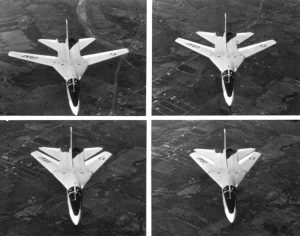21 December 1964 – The U.S. Air Force and Navy were both seeking new aircraft when Robert McNamara was appointed Secretary of Defense in January 1961.[14] The aircraft sought by the USAF and the Navy shared the need to carry heavy armament and fuel loads, feature high supersonic speed, twin engines, and two seats, and probably use variable geometry wings.[15] On 14 February 1961, McNamara formally directed the services to study the development of a single aircraft that would satisfy both requirements.
The Navy version would carry an AN/AWG-9 Pulse-Doppler radar and AIM-54 Phoenix missiles. The Air Force version would carry the AN/APQ-113 attack radar and the AN/APQ-110 terrain-following radar and air-to-ground armament.[22] A team of engineers at General Dynamics was led by Robert H. Widmer.[23]
Lacking experience with carrier-based fighters, General Dynamics teamed with Grumman for the assembly and testing of the F-111B aircraft. In addition, Grumman would also build the F-111A’s aft fuselage and the landing gear.[24] The General Dynamics and Grumman team faced ambitious requirements for range, weapons load, and aircraft weight.[25] The F-111 design also included new features on a production military aircraft, such as variable-geometry wings and afterburning turbofan engines.[24]

The F-111A mockup was inspected in September 1963. The first test F-111A was rolled out of Plant 4 of General Dynamics’ Fort Worth, Texas facility on 15 October 1964. It was powered by YTF30-P-1 turbofans and used a set of ejector seats as the escape capsule was not yet available.[22] The F-111A first flew on 21 December 1964 from Carswell Air Force Base, Texas, U.S.[26] The first F-111B was also equipped with ejector seats and first flew on 18 May 1965.
The name refers to the word “aardvark” which is Afrikaans for “earth pig” and reflects the look of the long nose of the aircraft that might remind one of the nose of the aardvark.
Source: Wikipedia
